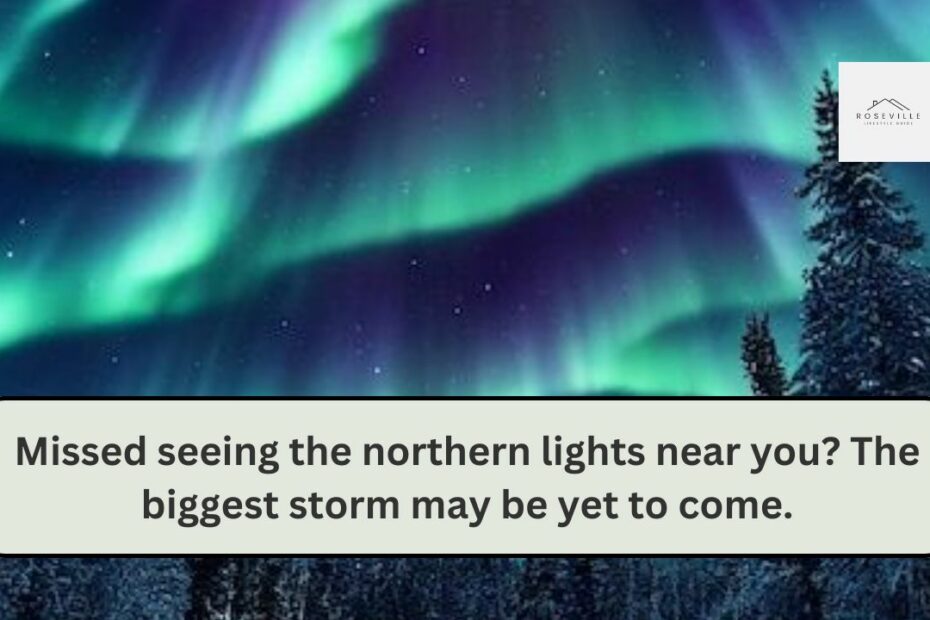The Northern Lights, or Aurora Borealis, are one of nature’s most stunning displays. These mesmerizing light displays, visible in the polar regions, captivate millions each year. If you missed out on seeing the Northern Lights recently, don’t worry—there might be an even more spectacular display on the horizon. Here’s why the biggest auroral storm could be yet to come and how you can prepare to catch it.
Understanding the Northern Lights
The Northern Lights occur when charged particles from the sun interact with Earth’s magnetic field and atmosphere. These particles, mainly electrons and protons, collide with gases like oxygen and nitrogen high in the atmosphere, creating beautiful light displays. The lights can appear as green, pink, red, yellow, blue, and violet hues, forming patterns such as arcs, swirls, and curtains across the sky.
The Solar Cycle and Auroral Activity
Auroral displays are closely tied to the solar cycle, an approximately 11-year cycle of solar activity. During the solar maximum phase, when solar activity is at its peak, the sun emits more solar flares and coronal mass ejections (CMEs). These solar events increase the number of charged particles reaching Earth, leading to more frequent and intense Northern Lights displays.
As we are currently transitioning from the solar minimum to the solar maximum of Solar Cycle 25, we are entering a period of heightened solar activity. This means that the likelihood of witnessing spectacular auroral displays is increasing. According to experts, the next few years could bring some of the most intense auroral storms in decades.
Recent Aurora Forecasts
In recent months, scientists have observed several significant solar flares and CMEs. These events have led to increased auroral activity, but the most spectacular displays are yet to come. Forecasts suggest that a major solar storm could hit Earth soon, potentially leading to an exceptional auroral display.
Aurora forecasts rely on monitoring solar wind conditions and geomagnetic activity. Instruments like the Solar and Heliospheric Observatory (SOHO) and the Advanced Composition Explorer (ACE) provide real-time data on solar wind and geomagnetic conditions. By analyzing this data, scientists can predict when and where auroral displays might be most visible.
Preparing for the Next Big Aurora
If you missed the recent auroras, here’s how you can prepare to catch the next big show:
- Stay Informed: Follow aurora forecasts from reputable sources like the NOAA Space Weather Prediction Center or the Geophysical Institute. Websites and apps like AuroraWatch or My Aurora Forecast can provide real-time alerts and predictions.
- Choose the Right Location: The Northern Lights are best viewed in areas with minimal light pollution and clear, dark skies. Look for viewing spots away from city lights, ideally in the northern latitudes if you’re in the Northern Hemisphere.
- Plan Ahead: Auroral activity is often stronger around the equinoxes (March and September). Plan your viewing during these times for a higher chance of witnessing a spectacular display.
- Dress Appropriately: Northern Lights viewing often requires being outside in cold weather. Dress warmly in layers to stay comfortable during long periods of observation.
- Be Patient and Persistent: Auroras can be unpredictable. Sometimes, you might have to wait for hours in the cold before the lights appear. Bring snacks, drinks, and entertainment to pass the time.
The Science Behind Solar Storms and Auroras
Solar storms, or geomagnetic storms, occur when solar wind and CMEs interact strongly with Earth’s magnetic field. These storms can enhance auroral activity by increasing the number of charged particles entering the Earth’s atmosphere. The more intense the solar storm, the more vivid and widespread the auroras can become.
The strength of an auroral display is measured using the KP index, which ranges from 0 (no auroras) to 9 (extreme auroras). During severe geomagnetic storms, the KP index can reach high levels, resulting in stunning auroras visible even at lower latitudes.
FAQ
1. How often do Northern Lights occur?
Northern Lights can occur throughout the year, but they are most visible during the fall and winter months when nights are longest and skies are darkest. Their frequency also increases during periods of heightened solar activity, such as during solar maximum.
2. What is the best time to see the Northern Lights?
The best time to see the Northern Lights is during the darkest months of the year, typically from September to April. They are usually visible between 10 PM and 2 AM local time, but this can vary depending on your location and the strength of the aurora.
3. Can you see the Northern Lights from anywhere?
The Northern Lights are typically visible in high-latitude regions near the Arctic Circle, including parts of Norway, Sweden, Finland, Canada, Alaska, and Russia. Occasionally, strong geomagnetic storms can make auroras visible at lower latitudes, but this is less common.
4. How can I improve my chances of seeing the Northern Lights?
To improve your chances, monitor aurora forecasts, choose a location with minimal light pollution, and go out during the peak viewing times. Be patient and prepared for cold weather conditions.
5. What should I do if I missed the Northern Lights?
If you missed the recent Northern Lights, stay optimistic. There are often multiple opportunities to view them over time. Keep an eye on solar activity forecasts and plan future trips to aurora-viewing locations to catch the next big display.
Conclusion
The Northern Lights are a breathtaking natural phenomenon that many people dream of witnessing. While missing a display can be disappointing, the possibility of an even more spectacular auroral storm in the near future offers hope. By staying informed, planning strategically, and preparing for the next opportunity, you can enhance your chances of experiencing one of nature’s most awe-inspiring spectacles. Keep an eye on the skies and the solar activity reports—your chance to witness the Northern Lights might be just around the corner.
| HOME | CLICK HERE |
| NORTHERN LIGHT | CLICK HERE |
